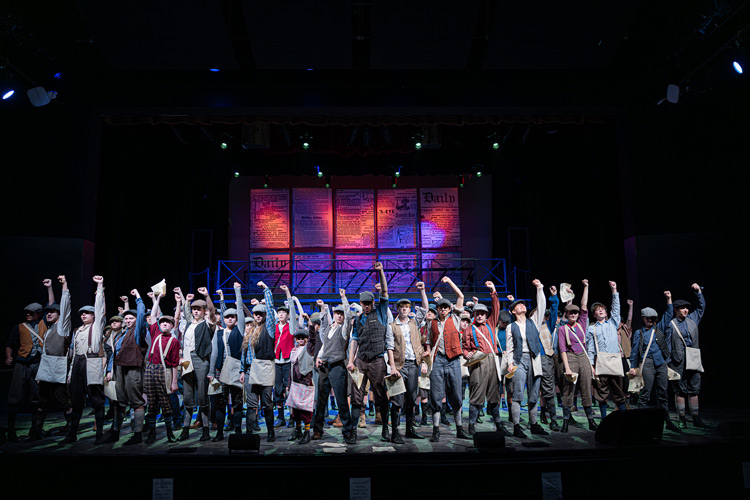By PAUL C. SWEENEY, Esq.
Guest Columnist
From the dugout to the wings
Growing up, I was all about sports, not theater. Aside from a blink-and-you’ll-miss-it role as “Banker #3” in Mary Poppins, I spent my youth on courts and fields, not stages. Fast forward a few decades of practicing law, I still never imagined I’d one day be comparing a courtroom to a stage.
But all that changed, unexpectedly, thanks to my kids and The Point Theater in Carmel. The Point is the Midwest’s largest youth theater known for its high-quality productions and focus on building character through the arts. After volunteering backstage for ten of their shows, I found myself looking at my own career through a new lens.
The courtroom, it turns out, shares quite a bit with the stage.

Working backstage on Newsies at The Point Theater gave one local attorney a new perspective on both entertainment and the practice of law. (Photo by Rob Slaven / IndyGhostLight.com)
Two plays, one stage
In every trial, two sides tell competing stories: plaintiff and defendant, or prosecution and defense. It’s like watching two theater companies performing different plays on the same stage. Each has its own director (attorney), cast (witnesses), and script (evidence and legal theory).
Timing is crucial. A well-placed objection or a compelling closing argument can change the whole dynamic, much like a perfectly delivered line or a dramatic pause on stage. And the jury? They’re the audience and the final critics.
The judge as stage manager
In the theater world, the stage manager ensures that everything runs smoothly. In the courtroom, that job belongs to the judge.
The judge doesn’t control the narrative, but ensures that rules are followed, transitions happen properly, and decorum is maintained. Their quiet authority keeps the entire production – from opening statements to verdict – on track.
The jury: audience & critics
Juries are unique in the courtroom performance. They’re not passive spectators, they’re the ones who decide how the story ends. They interpret the facts, judge the characters, and ultimately deliver the final act: the verdict.
My daughter had a remarkable experience with this while performing in 12 Angry Jurors at The Point. Thanks to Hamilton County’s Judge David Najjar, the cast rehearsed in a real courtroom and jury room. We even brought the show to a local school, where I joined two other local attorneys for a Q&A. That moment solidified for me how close trial work and theater truly are.
The stakes are real
Of course, courtroom drama has one major difference from the stage: the outcomes are real, and the stakes are often life-altering.
But the tools, storytelling, emotion, human connection, are the same. That’s why I often speak to students about the power of narrative and self-belief. At Merrillville High School, colleagues and I built a presentation around The Greatest Showman anthem “This Is Me,” encouraging students to own their voices and envision themselves in roles they may have once thought were out of reach.
As someone who moved to Indiana with little after my parents’ divorce, I know what it’s like to doubt yourself. But I had what I needed: two loving parents, great teachers, mentors, and neighbors, and a community that believed in me. I turned the chip on my shoulder into fuel and never looked back.
A new perspective
I never expected that volunteering backstage would transform how I see my own profession. But watching these talented kids on stage helped me realize that a courtroom isn’t just a place for legal arguments. It’s a place where stories are told, where truth is sought, and where every participant plays a role in the outcome.
And maybe that’s why The Greatest Showman hits home. One lyric from “This Is Me” sums it all up: “I am brave, I am bruised, I am who I’m meant to be – this is me.”
This is me. And it could be you. Whether you’re on stage, in court, or just finding your voice – there’s power in showing up, telling your story, and knowing it matters.
Paul C. Sweeney, Esq. has practiced law in Indiana for 28 years. He is Senior Counsel with Ice Miller LLP and a candidate for Judge, Hamilton Superior Court 9.


Be the first to comment on "Courtroom drama: how jury trials mirror live theater"